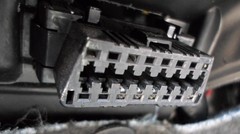EcoOBD2 chips are designed to boost your car’s fuel efficiency and hidden power by simply plugging into your vehicle’s OBD2 port. These green tuning boxes promise an easy upgrade, but sometimes you might need to reset the device. Understanding where is the reset button on EcoOBD2 and how to use it is key to ensuring optimal performance.
Locating the Reset Button on Your EcoOBD2 Chip
The reset button on your EcoOBD2 is intentionally small and discreet. It’s designed to prevent accidental resets while still being accessible when needed. You can typically find the reset button as a tiny pinhole located on the face of the EcoOBD2 device, usually near the logo.
To give you a clearer picture, consider the common design:
This image highlights a typical EcoOBD2 device. Look closely at the area around the logo, and you should be able to spot a small hole – that’s your reset button.
Step-by-Step Guide to Resetting Your EcoOBD2
Resetting your EcoOBD2 chip is a straightforward process. Here’s how to do it:
-
Turn off your ignition: Make sure your car’s ignition is completely off and the key is removed.
-
Locate the OBD2 port: This port is usually found under the steering wheel. Refer to your car’s manual if you’re unsure, or check online resources for your specific car model.
-
Plug in EcoOBD2: Insert the EcoOBD2 chip firmly into the OBD2 port.
-
Turn ignition to ACC mode: Insert your car key and turn it to the “ACC” (Accessory) position. This is usually one click to the right, before starting the engine.
-
Press the reset button: Using a pin or a similar small object, gently press and hold the reset button located on the EcoOBD2 for about 5 seconds.
-
Release and wait: Release the reset button and wait for approximately 30-40 seconds. This allows the EcoOBD2 to communicate and establish a connection with your car’s ECU (Engine Control Unit).
-
Start your engine: Start your car engine as usual. Your EcoOBD2 should now be reset and recalibrated.
Why You Might Need to Reset Your EcoOBD2
While EcoOBD2 chips are designed to be plug-and-play, there are a few scenarios where a reset might be beneficial:
- Initial Installation Issues: If you encounter problems after the initial installation, resetting can help re-establish the connection with your ECU.
- Troubleshooting Performance: If you suspect the EcoOBD2 isn’t performing as expected, a reset can sometimes resolve minor software glitches.
- Moving to a Different Car (Though Not Recommended): While EcoOBD2 is designed for one car, if you were to theoretically move it, a reset would be necessary for recalibration. However, it’s generally recommended to use a new chip for a different vehicle.
FAQs About the EcoOBD2 Reset Button
Q: Do I need to reset EcoOBD2 every time I start my car?
A: No, you only need to reset the EcoOBD2 during the initial installation or if you are troubleshooting issues. Once calibrated, it should function automatically.
Q: What happens if I accidentally press the reset button?
A: Accidentally pressing the reset button shouldn’t cause harm, but it will restart the calibration process. You may just need to wait the 30-40 seconds again for it to reconnect with the ECU.
Q: Is it safe to use a pin to press the reset button?
A: Yes, it is safe to use a pin or similar small, non-metallic object to press the reset button gently. Avoid using excessive force.
Q: Will resetting EcoOBD2 void my car warranty?
A: No, resetting the EcoOBD2 will not void your car warranty. Like the initial plug-in, resetting is part of the device’s normal operation and doesn’t involve any permanent modifications to your vehicle. Unplugging the device returns your car to its factory settings.
Beware of Fakes
Finally, when dealing with EcoOBD2 chips, especially online, be cautious of counterfeit products.
Ensure you purchase from reputable sources to guarantee you receive a genuine and safe EcoOBD2 chip that will perform as intended and have the reset button in the expected location. Enjoy the potential fuel efficiency and performance gains of your EcoOBD2!
